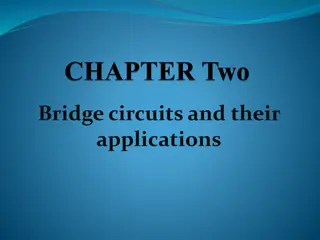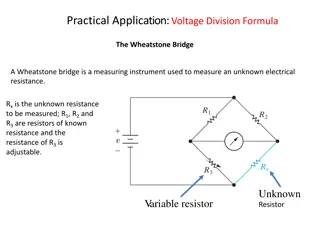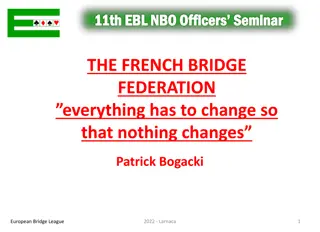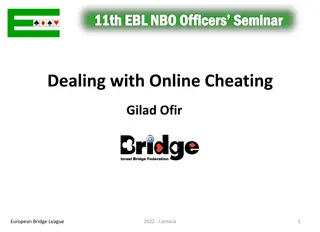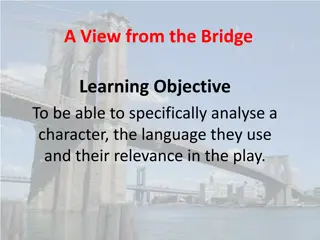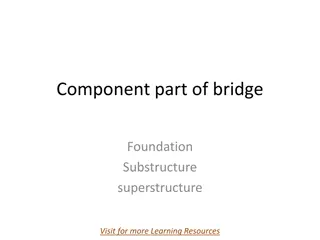Mastering Bridge Pre-empts: Strategies and Techniques Revealed
Explore the key concepts of pre-emptive bidding in bridge, including evaluating hands, counting playing tricks, and understanding the rule of 2, 3, and 4. Uncover the aims of pre-empts, the strength of the pre-emptor's main suit, and side values to enhance your bridge game. Enhance your skills in declarer play, defense, and bidding to master the most challenging aspects of bridge.
Download Presentation

Please find below an Image/Link to download the presentation.
The content on the website is provided AS IS for your information and personal use only. It may not be sold, licensed, or shared on other websites without obtaining consent from the author. Download presentation by click this link. If you encounter any issues during the download, it is possible that the publisher has removed the file from their server.
E N D
Presentation Transcript
Bridge Lecture on Pre-empts: The Rule of 2, 3 and 4 By Stefan Skorchev 16.July, Opatija, Croatia
Which is the most difficult part in Bridge? A. Declarer play B. Defense C. Bidding
The aims of a pre-empt To interrupt the opponents bidding by cutting short their bidding space; To reach a contract ourselves either to make it or as a sacrifice.
Evaluating pre-emptive hands High card points (HCPs) vs Playing tricks (PTs)
How to count Playing tricks 13 minus Number of losers = Number of Playing tricks
Example AKQ852 -missing none of the top three cards, therefore no losers in ; 942 -missing all three top cards, therefore 3 losers in ; 73 -missing all 3 top cards, but we only follow twice, therefore 2 losers in ; T6 -exactly the same as the diamond suit 2 losers in .
How many Playing tricks can you count? Hand A 72 83 KQJ7432 94 Hand B 84 AQJ7532 852 T Hand C 72 8 KQJ743 JT63 Hand D 84 AQJ753 8 T864
Strength of the pre-emptors main suit and side values -Pre-empting at the 2 level: have at least 2 of the honours (A, K, Q, J); -Pre-empting at the 3 level: have 2 out of the top 3 cards (A, K, Q) or only one of them accompanied by JT; -Pre-empting at the 4 level: on a 7-card suit 3 out of the top 5 cards; on a 6- card suit have 4 out of the top 5 cards in the suit a self-sufficient suit.
The Rule of Two, Three, Four 1. Unfavourable vulnerabilities add 2 tricks to the value of your hand; 2. Equal vulnerabilities add 3 tricks to the value of your hand; 3. Favourable vulnerabilities add 4 tricks to the value of your hand.
Example They ve opened 1 in front of us, and we need to bid with: KQJ9753 73 852 4 1 loser in , 2 losers in , 3 in and 1 in - 7 losers 6 PTs -in unfavourable vulnerabilities 6 PTs + 2 added tricks = 8 => overcall 2 -in equal vulnerabilities 6 PTs + 3 added tricks = 9 => overcall 3 -in favourable vulnerabilities 6 PTs + 4 added tricks =10=> overcall 4
Sacrificing Doubled undertricks Non-vulnerable Vulnerable -1 100 200 -2 300 500 -3 500 800 -4 800 1100
Example The left-hand opponent opened 1 , partner overcalled with 4 with favourable vulnerability, right-hand opponent bid 5 , and we need to decide what to bid holding: K82 T9 A763 8632
Disclaimer Do not pre-empt if partner is not a passed hand and we have 4-card major suit on the side we may miss finding a game/slam in that 4-card major suit; Deciding whether to pre-empt with only 6 cards in the main suit at level 4 do have a self-sufficient suit (4 out of the top 5 cards) to guarantee trump control, even opposite a singleton/void in partner s hand; Do not have more than one potential defensive trick in total (A, K or Q) in all side suits; Do not pre-empt higher than 4 of a major or 5 of a minor level; The pre-emptor doesn t bid again! (unless asked to after 2N relay or a cue- bid).



